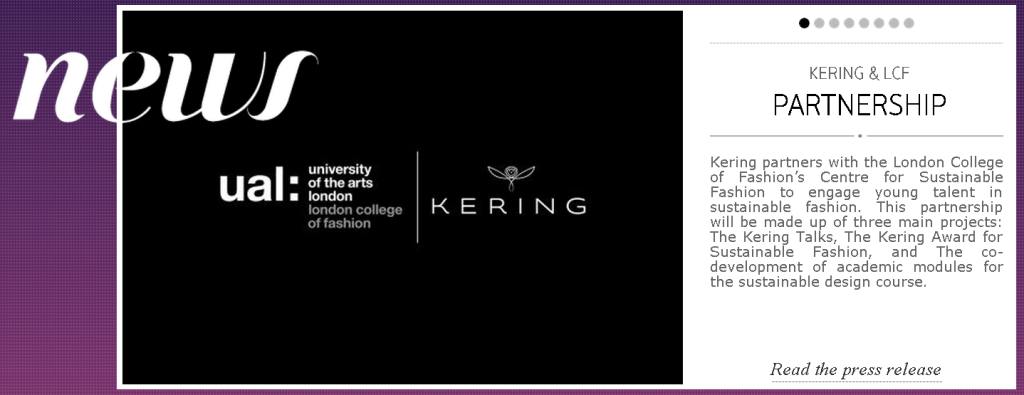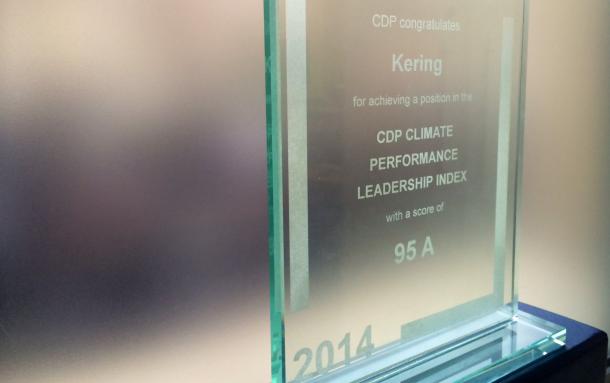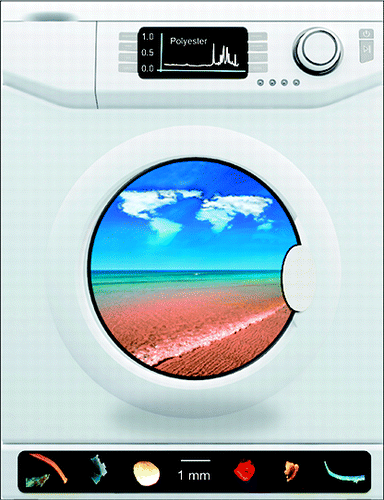This week’s headlines
October 25-31
Kering Partners With London College Of Fashion to Support Sustainability

October 27, 2014
Kering, the French luxury apparel conglomerate, and the Center for Sustainable Fashion at the London College of Fashion have announced a partnership to promote sustainability in the fashion industry. The deal was set for five years and it’s intended to support the ethical side of fashion through various initiatives.
The following are the group’s brands:
Luxury: Gucci, Bottega Veneta, Saint Laurent, Alexander McQueen, Balenciaga, Brioni, Christopher Kane, McQ, Stella McCartney, Tomas Maier, Sergio Rossi, Boucheron, Dodo, Girard-Perregaux, JEANRICHARD, Pomellato and Qeelin.
Sport & Lifestyle: Puma, Volcom, Cobra, Electric and Tretorn.
“As our industry continues to develop and our business grows, we need successive generations to keep driving change,” François-Henri Pinault, chairman and chief executive of Kering, said in a statement, according to the Telegraph.
This october, Kering was included in the CDP Climate Performance Leadership Index 2014’ (CPLI), receiving an award from the Carbon Disclosure Project for being one of 10 French companies with an “A” performance grade. Also Kering was recently named industry leader of the Dow Jones Sustainability Indices (DJSI) World and Europe topping the ranking in the Textiles, Apparel & Luxury Goods category.

The Real Pollution Caused by Synthetic Fibers

A paper by Mark Brown and others published in 2011 revealed the effects cause by microfibers migrating into water systems. At the time, the paper did not originate much response from companies or the general public. The Guardian published an update on Browne’s endeavor this week. Some of the study’s key findings:
- 85% of the human-made material found on the shoreline were microfibers, and matched the types of material, such as nylon and acrylic, used in clothing.
- Browne estimated that around 1,900 individual fibers can be rinsed off a single synthetic garment – ending up in our oceans.
According to the article, companies like Patagonia, Nike and Polartec did not give Browne the support he was looking for when trying to find research partners. After looking for support under a strategy called Benign by Design, one firm helped him with a $10,00 grant: Eileen Fisher.
According to The Guardian: “he’s still hoping to find a clothing company that will collaborate on research and development of new synthetic fabrics that will not shed microfibers”.
The article exposes some of Browne’s interactions with brands that claim to care for sustainability in which they revealed the reasons for not collaborating with him. Polartec countered saying that they do their own research but then refused to reveal the specific data of their studies, and Patagonia considered Browne’s findings to preliminary to dedicate resources to, as they needed more evidence that such an investment will really have an impact on a broader problem.
Until either companies, governments or individuals are willing to invest in this kind of research, it remains unclear what are the real effects of fiber pollution in water ecosystems and what alternatives can be used to decrease it.
Here is the abstract of Browne’s 2011 paper: Accumulation of Microplastic on Shorelines Woldwide: Sources and Sinks:
Plastic debris <1 mm (defined here as microplastic) is accumulating in marine habitats. Ingestion of microplastic provides a potential pathway for the transfer of pollutants, monomers, and plastic-additives to organisms with uncertain consequences for their health. Here, we show that microplastic contaminates the shorelines at 18 sites worldwide representing six continents from the poles to the equator, with more material in densely populated areas, but no clear relationship between the abundance of miocroplastics and the mean size-distribution of natural particulates. An important source of microplastic appears to be through sewage contaminated by fibers from washing clothes. Forensic evaluation of microplastic from sediments showed that the proportions of polyester and acrylic fibers used in clothing resembled those found in habitats that receive sewage-discharges and sewage-effluent itself. Experiments sampling wastewater from domestic washing machines demonstrated that a single garment can produce >1900 fibers per wash. This suggests that a large proportion of microplastic fibers found in the marine environment may be derived from sewage as a consequence of washing of clothes. As the human population grows and people use more synthetic textiles, contamination of habitats and animals by microplastic is likely to increase.
Accumulation of Microplastic on Shorelines Woldwide: Sources and Sinks. Mark Anthony Browne, Phillip Crump, Stewart J. Niven, Emma Teuten, Andrew Tonkin, Tamara Galloway, and Richard Thompson. Environmental Science & Technology 2011 45 (21), 9175-9179
Read the article Published on The Guardian, October 27, 2014
Happy Halloween!

I always loved Halloween and growing up in a country where it is not a big deal, I never cared for social conventions, even at 7 I was doing my own thing and celebrating it anyway ♥ I am excited to get my first Trick-or-Treaters tonight!
